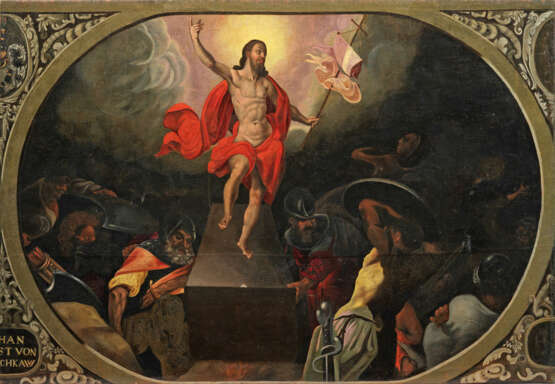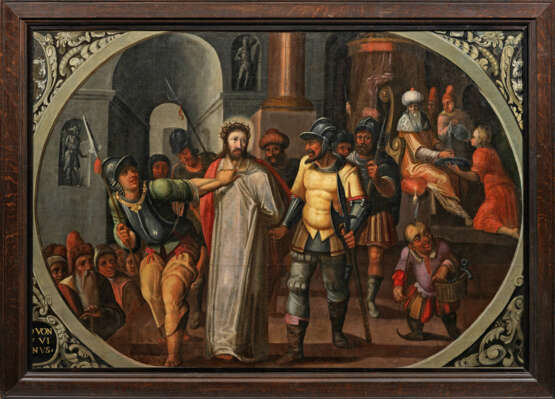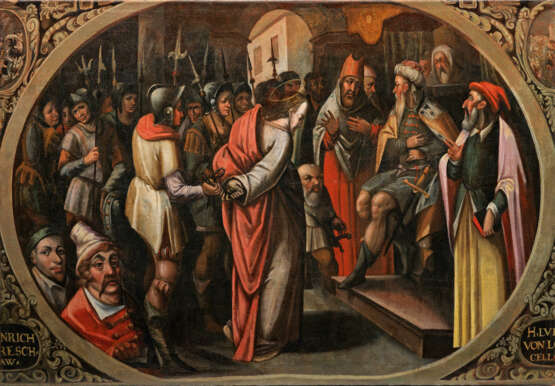ID 1340777
Lot 1606 | Norddeutscher Manierist in der Nachfolge von Maerten de Vos
Estimate value
€ 7 500 – 15 000
(1532 Antwerpen - 1603 ebenda) tätig 1. Hälfte 17. Jh.
Folge von drei großen Gemälden mit Passionsszenen
Die querovalen Kompositionen geben in vielfigurigen Szenen verschiedene Erzählungen aus der Passionsgeschichte nach den Evangelien im Neuen Testament wieder. In zwei Gemälden wird der gefangene, von Schergen umringte Jesus Christus vor Herodes bzw. im Palast des römischen Statthalters Pontius Pilatus, der seine Hände nach der Verurteilung in Unschuld wäscht (Matth. 27,24-26) gezeigt. Das dritte Gemälde schildert die Auferstehung Jesu Christi, flankiert von schlafenden sowie von Angst erfüllten, aufgeschreckten Wächtern (Matth. 28, 4). In den angeschnittenen Zwickeln befinden sich Kartuschen mit Wappen und Namen von Stiftern, umrahmt von Akanthusranken. Die manieristischen Darstellungen basieren vermutlich auf Kupferstichen von Maerten de Vos oder sind durch diese inspiriert. Der Künstler hat hierbei zur Ausdruckssteigerung in der Schilderung des Geschehens, jedoch insbesondere bei den jüdischen Figuren und den Schergen ihre Statur, Physiognomie, Gestik und Mimik grotesk gesteigert. Öl/Lwd., teilw. doubl.; 118,5 cm-120,5 cm x 174 cm-176 cm. Ein Gemälde mit Rahmen.
Die Gemälde wurden 1990 in der Ausstellung "Bilder der Reformation" im Museum Hameln gezeigt und seinerzeit Hans von Aachen zugeschrieben.
Provenienz: Laut mündlicher Überlieferung aus dem Besitz des Königshauses von Hannover; Auktion Schloss Hagenburg, 9.3.2002; seitdem in deutscher Privatsammlung.
North German follower of Maerten de Vos (1532 - 1603), active first half 17th C.; Series of three Mannerist paintings depicting the Passion of Jesus. Oil on canvas, partially relined.
| Address of auction |
Kunstauktionshaus Schloss Ahlden GmbH Große Str. 1 29691 Ahlden(Aller) Germany | ||||||||||||||
|---|---|---|---|---|---|---|---|---|---|---|---|---|---|---|---|
| Preview | |||||||||||||||
| Phone | +49 5164 80100 | ||||||||||||||
| Buyer Premium | 25.0 | ||||||||||||||
| Conditions of purchase | Conditions of purchase | ||||||||||||||
| Business hours | Business hours
|





